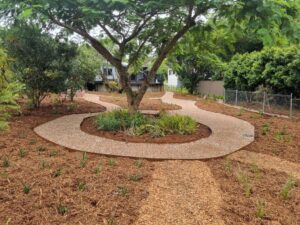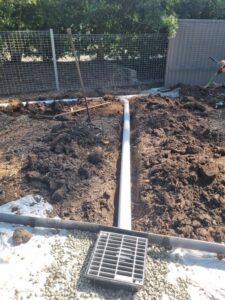
Seeking inspiration
By Patrick Regnault
Designing a garden requires a multiskilled approach. Plant and soil knowledge, an understanding of the influence of topography and geology on weather patterns, an ability to observe the local fauna and flora, a good grasp of engineering and construction, planning and scheduling proficiency, communication skills, and basic financial comprehension are all needed. And then, something that is hard to pin down: vision, flair, and inspiration.
Plants and soil
It seems obvious, but we must understand the importance of local knowledge. The soil of a coastal area may look sandy, but in some areas, the clay subsoil is only 400mm below, which can create waterlogging problems. If there are native remnants nearby, this can give us an indication of the type of subterranean pre-existing conditions we are dealing with.

Topography, geology and weather patterns
I have grouped those three together as they influence each other at least to some degree locally. Topography greatly influences wind patterns and rainfall. Valleys and mountain ranges can redirect, elevate, or change wind and rain conditions such as creating windy corridors or rain shadows. A landscape’s lithologic features can impact the hydrology of a site.
Fauna and flora
Observing the type of wildlife that is near the site, we can design to favour certain species or repel others. Small birds and pollinators are often very appealing to clients and at risk in the general area. What attracts them and what they need to feed, shelter and reproduce can be very specific. As an example, the Richmond birdwing butterfly larvae eat the leaves of Pararistolochia praevenosa but are poisoned by the leaves of Aristolochia rigens.
Engineering and construction
A garden may require retaining walls, paths, drainage, and garden structures. Without a personal or collaborative understanding of those two essential components, the designer will have to rely entirely on the quality of the landscaper, unless he or she is the person implementing the design.

Planning and scheduling
Planning and scheduling works in tandem with finance and communication. Designing a garden needs to be done with a clear budget in mind. If it is ever to be built, it must be designed within a reasonable budget that the client can afford. Another way is to design it so the client can do it over time, but this must be clearly explained. A budget for the subsequent maintenance also needs to be allocated. Low maintenance gardens can be done, but zero maintenance is non-existent.
A planting schedule needs to consider what is available in nurseries and will grow on a particular site. Plant size and rate of growth are important. Choosing plants that are suited to the conditions will ensure faster growth, pest resistance, and a thriving garden.
The creative juices
The hardest part to explain is how ideas come when designing a garden. Where those ideas come from is easier to explain. As designers, we see other garden creations that leave a mark on our minds. For me, it is not only gardens that inspire me. Looking at nature, paintings, sculptures, and all art forms and craftsmanship leaves traces in my mind. Some are conscious, and others have more subtle imprints in forms, shapes, and colours. To nourish the muses, we may find that we cannot separate our garden design from humanity’s greatest asset, shared imagination.
A good designer grounds their vision in practicality and integrity. Of course, what we do must be pleasing to the eye, but aesthetics alone is insufficient. Gardens need to be workable, easy to access and move around in, but don’t they also need to be alive with sounds and smells? Healthy gardens are places shared, inhabited by all types of creatures. A living garden is biodiverse, and a biodiverse garden improves the life of people who use it and look at it.
We live in a world full of extremes and stimulation. Our nervous system is constantly challenged and on alert. A garden is a place where we can settle, feel safe and peaceful, where life and decay are in harmony, and where our eyes can soften.
Patrick Regnault FAIH RH0062
Interactive Landscapes
E: patrickregnault@hotmail.com
